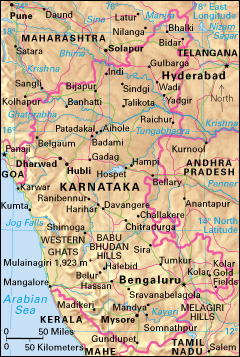Mysore (pop. 893,062) is a major city in the southern part of the Indian state of Karnataka. It is the second largest city in Karnataka. Only Bengaluru has more people. Mysore is a major center for tourism in south India.

The city’s main natural landmark is Chamundi Hill, which rises east of the city and towers over it. On the hillside, there is a black granite statue of Nandi, the bull belonging to the Hindu god Shiva. This statue attracts many pilgrims. At the top of the hill, there is a temple as well as a palace.
Mysore’s notable buildings include the Maharajah’s Palace, which contains the throne of the Mysore royal family. This throne is made of gold and ivory and is studded with precious stones. Every year in September or October, the residents of Mysore celebrate Dasara, which has its origins as a royal festival. On the last day of the 10-day festival, there is a procession through the streets of the city.
Mysore is a major center for the manufacture of incense, as well as for the production of silk and sandalwood oil. Mysore also has textile and chemical industries. Mysore is a major transport junction. Two railroad lines meet there, as do a number of major roads. Mysore also has an airport. The University of Mysore, founded in 1916, is the oldest in Karnataka.
Srirangapatnam, which preceded Mysore as the capital of the maharajahs of Mysore, lies to the north of the city of Mysore. Tipu Sultan and his forces were defeated by the British under Lord Wellesley, the brother of the Duke of Wellington, in a battle there in 1799. The rulers of the region were then firmly under British influence. Somnathpur, which contains a number of ancient Hindu temples, is also nearby.
Mysore was at one time the capital of the princely state of Mysore, which became part of India upon Indian independence in 1947. A new, enlarged state called Mysore was formed in 1956. The state changed its name to Karnataka in 1973.
